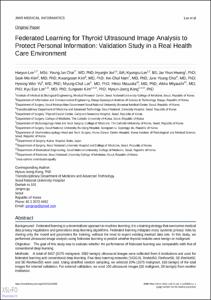Department of Electrical Engineering and Computer Science
MBIS(Multimodal Biomedical Imaging and System) Laboratory
1. Journal Articles
Federated learning for thyroid ultrasound image analysis to protect personal information: Validation study in a real health care environment
- Title
- Federated learning for thyroid ultrasound image analysis to protect personal information: Validation study in a real health care environment
- Author(s)
- Lee, Haeyun ; Chai, Young Jun ; Joo, Hyunjin ; Lee, Kyungsu ; Hwang, Jae Youn ; Kim, Seok-Mo ; Kim, Kwangsoon ; Nam, Inn-Chul ; Choi, June Young ; Yu, Hyeong Won ; Lee, Myung-Chul ; Masuoka, Hiroo ; Miyauchi, Akira ; Lee, Kyu Eun ; Kim, Sungwan ; Kong, Hyoun-Joong
- DGIST Authors
- Lee, Haeyun ; Chai, Young Jun ; Joo, Hyunjin ; Lee, Kyungsu ; Hwang, Jae Youn ; Kim, Seok-Mo ; Kim, Kwangsoon ; Nam, Inn-Chul ; Choi, June Young ; Yu, Hyeong Won ; Lee, Myung-Chul ; Masuoka, Hiroo ; Miyauchi, Akira ; Lee, Kyu Eun ; Kim, Sungwan ; Kong, Hyoun-Joong
- Issued Date
- 2021-05
- Type
- Article
- Author Keywords
- deep learning ; federated learning ; thyroid nodules ; ultrasound image
- Keywords
- CANCER ; CLASSIFICATION
- ISSN
- 2291-9694
- Abstract
- Background: Federated learning is a decentralized approach to machine learning; it is a training strategy that overcomes medical data privacy regulations and generalizes deep learning algorithms. Federated learning mitigates many systemic privacy risks by sharing only the model and parameters for training, without the need to export existing medical data sets. In this study, we performed ultrasound image analysis using federated learning to predict whether thyroid nodules were benign or malignant. Objective: The goal of this study was to evaluate whether the performance of federated learning was comparable with that of conventional deep learning. Methods: A total of 8457 (5375 malignant, 3082 benign) ultrasound images were collected from 6 institutions and used for federated learning and conventional deep learning. Five deep learning networks (VGG19, ResNet50, ResNext50, SE-ResNet50, and SE-ResNext50) were used. Using stratified random sampling, we selected 20% (1075 malignant, 616 benign) of the total images for internal validation. For external validation, we used 100 ultrasound images (50 malignant, 50 benign) from another institution Results: For internal validation, the area under the receiver operating characteristic (AUROC) curve for federated learning was between 78.88% and 87.56%, and the AUROC for conventional deep learning was between 82.61% and 91.57%. For external validation, the AUROC for federated learning was between 75.20% and 86.72%, and the AUROC curve for conventional deep learning was between 73.04% and 91.04%. Conclusions: We demonstrated that the performance of federated learning using decentralized data was comparable to that of conventional deep learning using pooled data. Federated learning might be potentially useful for analyzing medical images while protecting patients personal information. © 2021 JMIR Medical Informatics. All rights reserved.
- DOI
- 10.2196/25869
- Publisher
- JMIR Publications
- Related Researcher
-
-
Hwang, Jae Youn
- Research Interests Multimodal Imaging; High-Frequency Ultrasound Microbeam; Ultrasound Imaging and Analysis; 스마트 헬스케어; Biomedical optical system
-
- Files in This Item:
-
 기타 데이터 / 658.67 kB / Adobe PDF
download
기타 데이터 / 658.67 kB / Adobe PDF
download



